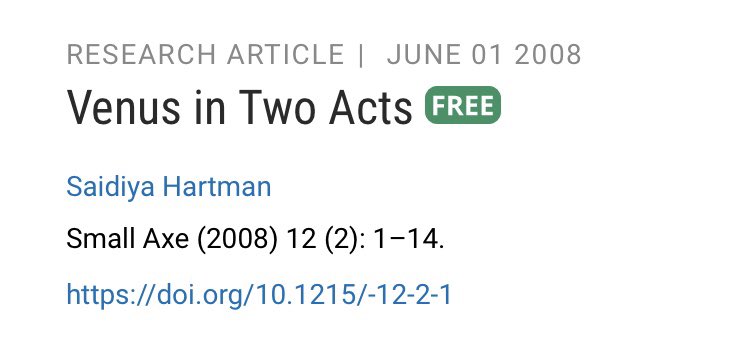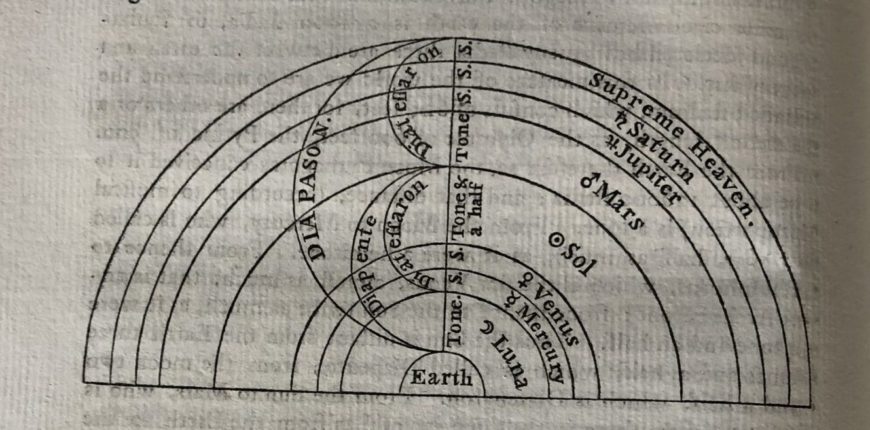The Venus II is a family operation and they take pride in their menu. I love not only the food there (and I've tried everything), but the family atmosphere as well. From the first day I walked in there, I was made to feel right at home and the service is impeccable. Venus is the planet of love, relationships, beauty, and finances. It influences the way we think about love, how we feel about being in a partnership, how we act on our needs and desires, and the role money and people play in our lives.
This is a review of Saidiya Hartman’s “Venus in Two Acts.” I have been thinking about how to make feminist literature more accessible, and I’ve decided to do a series of articles linking feminist literature to social happenings and issues. This is the first of a hopefully exciting journey.
To be black in America can be to remember dozens of afternoons spent on stoops in the summer - laughing, loving and living. In the same breath it can be to approximate where you were when Trayvon Martin’s name first slid through your lips; to remember where you were when Michael Brown was inducted into your living room as “another black man killed in America.”
At the same time, I am reminded that to be black in America is never to remember where you were when you first heard that Miriam Carey, a dental hygienist from Connecticut, had been shot and killed in a car chase in the nation’s capital. It is to never to be able to recall when you first knew that Tanisha Anderson, a schizophrenic mother of one in Cleveland, had been murdered by police, unarmed, outside her mother’s home.
And so it follows that to be a black woman in America is to navigate the mortality that blackness threatens within the intimacy of black community, whilst having to remember that you are also a woman, on your own. It is to split yourself into two daily, unconsciously and unnecessarily. It is to forever remain aware of the possibility of being overlooked.
In her essay Venus in Two Acts Saidiya Hartman interrogates the ability of the archive to document black life in the Middle Passage. More specifically, she wrestles with the erasure of black girls from the public memory of racial violence through an archival encounter with an enslaved “dead girl” named Venus, on board a British slave ship named Recovery, in 1792. Venus acts as a point of reckoning for the corporeal death that the slave ship enacts on black enslaved people and the social death that the archive facilitates in its failure to document black lives. Ultimately, Hartman questions the ability of the archive to hold black stories without re-victimizing their subjects. She then reveals the gaps within the archive of slavery and then proceeds to attempt to redress the violence that situates “Venus” as part of the collateral damage of a slave economy. In this political moment where many are coming to terms with the specific precarity of black womanhood, Saidiya Hartman’s Venus in Two Acts becomes a prophetic realization of the painful state of black women’s lives in public memory as well as a constructive template for the battles we shall have to wage in trying to do these stories justice.

Hartman begins her essay by telling us that Venus could have been “Harriet, Phibba Sara, Joanna, Rachel, Linda and Sally, she is found everywhere in the Atlantic World”. By invoking names of slaves that could have existed, she reminds us that the violence Venus experienced was spectacular yet at the same time so relatively mundane in the context of the trans-Atlantic slave trade, that it is hard to imagine that her specific “encounter with power” deserves any unique attention. In mapping out the systemic violence visited upon the bodies and memories of enslaved black women and girls, Hartman makes her readers recall that the normalization of such spectacular violence is the root of the dehumanization that black women have always encountered both in their lived experiences and in the archive. This is in part the essence of what Hartman wants to address – the double jeopardy that enslaved black women endured in both their lives and their afterlives.
Hartman imagines Venus’ tragedy as two fold. First, her body was ravaged and then “no one remembered her name, or recorded the things she said or observed that she refused to say anything at all”. She was at once killed and silenced. And so for Hartman the archive not only fails to memorialize Venus but also becomes “a death sentence, a tomb, a display of the violated body” when confronted with the stories of the enslaved.
Venus In Two Acts Hartman
In the face of such loss, Hartman asks questions and reworks the fragments of discourse she finds in the archive in an attempt to bring us closer to producing a biography of Venus. Through her pensive and sometimes exasperated tone, made obvious by the litany of the questions she asks, “how can narrative embody life in words and at the same time respect what we cannot know”, “Is it possible to construct a story from the locus of impossible speech or resurrect lives from the ruins?” she conveys her commitment to redressing the faults of the archive.
In the “The Second Act” she struggles through the painful work of re-constructing an account of Venus’ experience. She guides us through the thought processes that see her wrestling with the decision to not write about Venus in an effort to avoid romanticizing Venus’s trauma or to yield to the necessity of recounting Venus’ death. Though at times long-winded and contradictory, the transparency of this project is only made clear through such confusion – confusion that stems from the “irreparable violence of the Atlantic slave trade”, as the reader is reminded. Such confusion underscores the difficulty of constructing a narrative about under-documented enslaved people. In communicating the difficulty of such a task, Hartman creates a space for meaningful conversation on narrative construction, and its limitations, therefore democratizing the process of creating these stories.
In a political moment where black women’s bodies continue to be threatened by both violence and erasure; a moment, where some of us are mourning the double tragedy that black womanhood can be in America, such democratization of narrative building can aid in better memorializing black women who die in the hands of the state. Hartman is conscious of the political moment in which she is writing in and therefore extends her analysis of Venus to the present in order to help us make sense of the current state of black women in public life and memory. Hartman tells us that “if this story of Venus has any value at all it is in illuminating the way in which our age is tethered to hers”, a phenomenon that she describes as “the afterlife of property”. The killing and subsequent criminal portrayal of women and girls such as Miriam Carey and Tanisha Anderson are evidence of that tethering, of the fact that black women and girls still exist as “property” as “Venuses”. For Hartman, Venus is “Harriet, Phibba Sara, Joanna, Rachel, Linda and Sally”, but she is also Miriam, Tanisha, Michelle, Charleena and Aiyana. Venus is “found everywhere in the Atlantic World” both in the 17th century and today.
And whilst these women’s corporeal loss is not something we can salvage, “in the meantime” Hartman presses us to “recruit the past for the sake of the living”; “to produce knowledge for the sake of the past”. In the meantime, we are reminded that we can remember well. Because in a time where we are declaring that “all black lives matter”, we must make sure that the evidence of black women’s lives, these Venuses - as they lived, loved and worked- is undeniably present and forever haunting the public’s memory, at the very least
Link to Saidiya Hartman’s “Venus in Two Acts”: https://muse.jhu.edu/article/241115
Venus In Two Acts Summary
These are synastry overlay interpretations for Venus in the partner’s 10th, 11th and 12th houses. Sonic colors soundtrack download. (See instead: Venus overlays in 1st–3rd houses, or in 4th–6th houses, or in 7th–9th houses.)
Venus in 10th House Synastry Overlay
If your Venus is in your partner’s tenth house of a synastry overlay, you find it easy to put work before play in this relationship.
You (Venus person) see the house person as someone that can help you attain your goals and improve your status. The house person sees you as having creative talent, vision, and understanding in areas which they lack. There is a give and take here, and you work well together. Your skills or areas of expertise complement each other. You respect each other’s strengths and skills.
Your partnership could be productive and profitable for both of you, but this may be the only incentive to pursue a relationship. This overlay doesn’t add much of an emotional or romantic aspect, unless you consider business plans to be romantic. You’ll both desire to be the boss of this relationship.
Venus in 11th House Synastry Overlay
If your Venus is in your partner’s 11th house of a synastry overlay, you immediately like and accept your partner upon meeting them.
Right away, you are interested in sharing their interests. You want to know what their hopes and wishes for the future are. Your partner is flattered by your warm attention, but they’re not overwhelmed. They don’t consider your attraction to be overbearing, but rather easy-going, warm, and friendly.
Your partner knows that you accept them as they are, and they gladly behave open and free around you. You have fun together, enjoying many of the same social activities or hobbies. You’re relaxed around each other. You are both comfortable being intimate with each other and sharing your inner selves.
The most significant part of this overlay is that you make each other feel comfortable in your own skin, with all your weird habits. You have no fear of rejection because you accept each other as you are.

The attraction here is light and friendly, not necessarily deep and emotional. But this open atmosphere does draw you both to open up to each other and share your inner thoughts and dreams. While not entirely emotional, there is some depth to the type of intimate bond that this overlay can create. Although this overlay is excellent for friends, this is also a positive atmosphere in which romantic love can grow and thrive.
Venus in 12th House Synastry Overlay
If your Venus is in your partner’s 12th house of a synastry overlay, you find yourself deeply moved in strange ways by the house person. For example, you may not be a needy person, but you find yourself being very needy or vulnerable around the house person.

The house person may feel that you put out some “false advertising.” You (the Venus person) were one type of person when they met you, but in this relationship you act somewhat different. The house person can’t really understand certain aspects about you. They may feel that you are a dream come true, but at the same time, they’re not sure that this dream will last.
It’s the 12th house overlay affecting both of you. Something about this overlay makes you feel insecure, as if the relationship is going to end but you don’t know why. The Venus person tries to hold on to the relationship, which confuses the house person even more. The house person doesn’t know if you want to continue or end the relationship.

Venus In Two Acts Summary
There’s an ephemeral quality to this overlay, so enjoy this mystical union while you have it. Now you see it, soon you may not.

